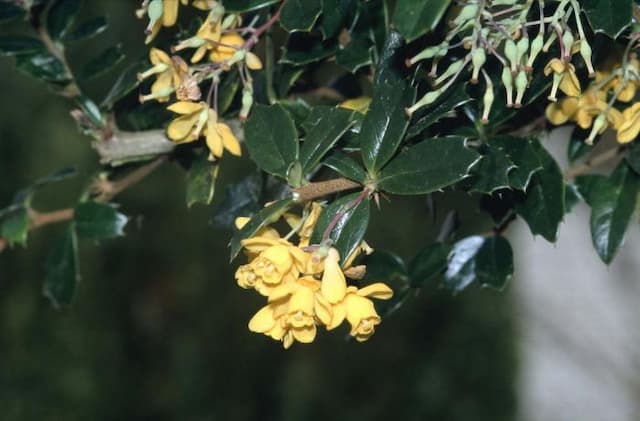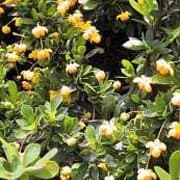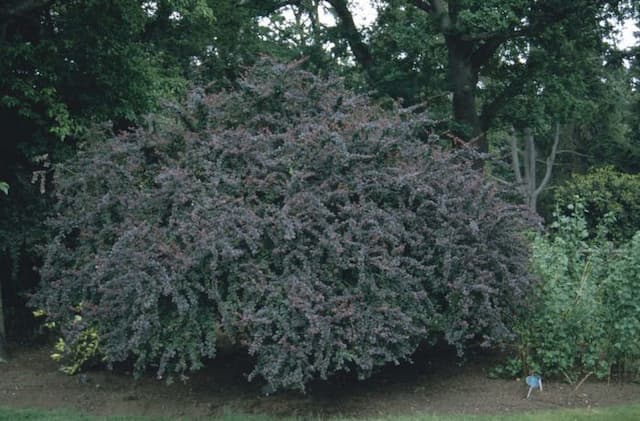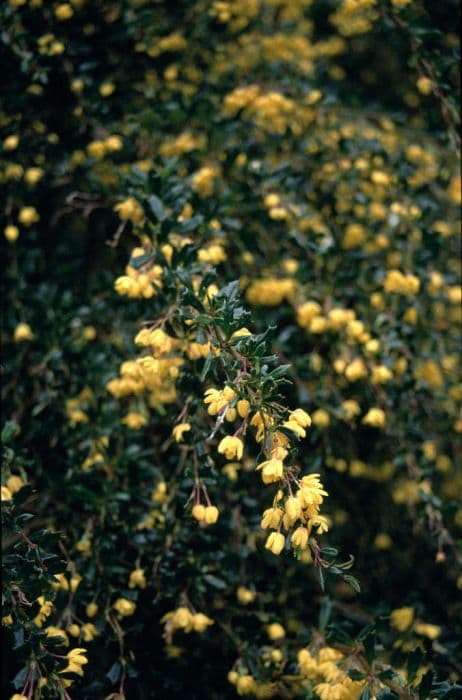Japanese barberry Berberis thunbergii f. atropurpurea 'Atropurpurea Nana'

ABOUT
The plant commonly known as the "Japanese barberry" is a compact, ornamental shrub that boasts striking foliage. Its leaves present a rich, reddish-purple hue that adds a dramatic splash of color to any landscape. The leaves are small and oval-shaped, with smooth edges, forming a dense, thorny thicket that is as visually intriguing as it is formidable. Throughout the growing season, the deep color of the foliage is consistent, making it a standout choice for gardeners looking to add contrast to their plantings. In spring, delicate yellow flowers emerge, hanging in small clusters along the length of the branches. These blooms add a soft, subtle charm to the plant's otherwise bold appearance. Following the flowering period, the Japanese barberry produces small, bright red berries that add an additional layer of visual interest. These berries persist through the fall and often into the winter, providing a vibrant pop of color against the barren landscape and potentially attracting birds and other wildlife. The overall visual impact of this shrub is that of a richly-colored, dense, and textured specimen that provides year-round ornamental value to gardens and landscaping projects.
About this plant
 Names
NamesSynonyms
Dwarf Purpleleaf Japanese Barberry, Crimson Pygmy Barberry, Red Leaf Japanese Barberry, Ruby Carousel Barberry, Concorde Barberry, Atro Nana Barberry.
Common names
Berberis thunbergii var. atropurpurea 'Nana', Berberis thunbergii 'Crimson Pygmy', Berberis thunbergii 'Little Favorite', Berberis thunbergii 'Atropurpurea Nana'.
 Toxicity
ToxicityTo humans
The Japanese Barberry plant can be potentially toxic to humans if ingested. The berries contain berberine, which is a compound associated with gastrointestinal distress, including vomiting, diarrhea, and nausea. Ingesting significant quantities of the plant may necessitate medical attention.
To pets
Japanese Barberry is also considered toxic to pets. If a pet ingests part of this plant, they may experience symptoms similar to those in humans, such as vomiting, diarrhea, and lethargy. If you suspect your pet has consumed any part of the plant, it is important to seek veterinary care promptly.
 Characteristics
CharacteristicsLife cycle
Perennials
Foliage type
Deciduous
Color of leaves
Purple
Flower color
Yellow
Height
2 feet [0.61 meters]
Spread
2 feet [0.61 meters]
Plant type
Shrub
Hardiness zones
4
Native area
Japan
Benefits
 General Benefits
General Benefits- Easy to maintain - The Japanese barberry ‘Atropurpurea Nana’ is relatively low maintenance and can thrive in a variety of soil conditions.
- Drought tolerant - Once established, this plant has good resistance to drought, reducing the need for frequent watering.
- Compact growth - With its small stature and slow growth rate, it is ideal for limited space gardens or as a low hedge.
- Seasonal interest - Its purplish-red foliage adds a distinctive color contrast to landscapes throughout the growing season.
- Winter hardy - It can withstand cold temperatures, making it suitable for a range of climates and extending its visual interest into the winter months.
- Erosion control - The root system can help to stabilize slopes and prevent soil erosion.
- Pest resistant - It is generally resistant to pests, which reduces the need for chemical treatments.
- Attracts wildlife - The berries produced can serve as food for birds, though it is essential to note that the seeds can be spread by birds, which could potentially lead to invasive behavior in some regions.
 Medical Properties
Medical PropertiesThis plant is not used for medical purposes.
 Air-purifying Qualities
Air-purifying QualitiesThis plant is not specifically known for air purifying qualities.
 Other Uses
Other Uses- Crafting natural dyes: The bark and roots of the Japanese barberry can be used to extract yellow, gold, and greenish dyes for textile art.
- Photography: Japanese barberry's vibrant foliage and fruit can be used as a subject in landscape photography, especially in the fall when its color is most intense.
- Winter garden interest: Because of its persistent berries and reddish-purple leaves, it provides visual appeal in a winter garden when most plants have died back.
- Garden barrier: The thorny nature of the shrub can be used to create a natural barrier or hedge to deter trespassers or animals.
- Bonsai creation: The 'Atropurpurea Nana' variant of Japanese barberry is sometimes grown as a bonsai due to its small size and ornamental look.
- Erosion control: This plant can be used on slopes and banks to help prevent soil erosion due to its dense growing habit.
- Wildlife shelter: The dense foliage offers shelter for birds and small animals, while its berries serve as a food source in the colder months.
- Topiary art: Gardeners may train and prune Japanese barberry into different shapes for decorative purposes in gardens and landscapes.
- Fall foliage tours: The bright autumn color of Japanese barberry makes it a significant attraction for areas that offer fall foliage sightseeing opportunities.
- Theme gardens: Its distinct purple foliage can be used to create a color-themed garden or to accent gardens with a specific color palette.
Interesting Facts
 Feng Shui
Feng ShuiThe Japanese Barberry is not used in Feng Shui practice.
 Zodiac Sign Compitability
Zodiac Sign CompitabilityThe Japanese Barberry is not used in astrology practice.
 Plant Symbolism
Plant Symbolism- Protection: The Japanese barberry, due to its thorns, is commonly associated with protection and setting boundaries.
- Intriguing Beauty: Its reddish-purple leaves that remain beautiful throughout the growing season symbolize the idea that beauty can be found in the resilience and hardiness of certain entities against adverse conditions.
- Adaptability: Given its ability to thrive in a variety of soil types, the Japanese barberry symbolizes adaptability and the easiness to adjust to different life situations.
 Water
WaterThe Crimson Pygmy Barberry should be watered regularly, especially during dry spells, aiming for about 1 inch of water per week. During the growing season, watering deeply once or twice a week is preferable to shallow watering every day, as it encourages deeper root growth. The soil should be allowed to dry out slightly between waterings to prevent root rot. Using a soaker hose or drip irrigation can provide efficient water delivery at soil level. In hotter periods, monitoring the soil moisture is important, as the plant may need additional water. Adjustments to the watering schedule should be made during the fall and winter when the plant is dormant and requires less water.
 Light
LightCrimson Pygmy Barberry thrives best in full sun to partial shade. Plant it in a spot where it can receive at least 6 hours of direct sunlight daily, as full sun encourages the richest foliage coloration. However, it can also tolerate some light shade, especially during the hottest part of the day, but too much shade may result in less vibrant foliage and sparser growth.
 Temperature
TemperatureCrimson Pygmy Barberry is hardy and adaptable to various temperature ranges, performing well from USDA hardiness zones 4 through 8. It can tolerate minimum temperatures down to -30°F to -20°F. Ideally, the plant enjoys temperate conditions and can survive in heat up to 100°F, although extremely high temperatures can stress the plant. Ensuring proper mulching can help regulate soil temperature and moisture.
 Pruning
PruningPruning Crimson Pygmy Barberry is essential to maintain its shape, remove any dead or diseased branches, and encourage new growth. It is best pruned in late winter or early spring before new growth begins. Generally, pruning once a year is adequate, but additional light trimming can be done throughout the growing season to tidy up the plant. Always use clean, sharp pruning tools to make clean cuts without damaging the stems.
 Cleaning
CleaningAs needed
 Soil
SoilJapanese Barberry 'Atropurpurea Nana' thrives in well-draining soil with a pH ranging from 6.0 to 7.5. A good soil mix would be one part garden soil, one part peat moss or compost, and one part perlite or sand for drainage.
 Repotting
RepottingJapanese Barberry 'Atropurpurea Nana' is a slow-growing shrub that typically doesn't require frequent repotting. It should be repotted when it outgrows its current pot, which may be every 2-3 years.
 Humidity & Misting
Humidity & MistingJapanese Barberry 'Atropurpurea Nana' is tolerant of a wide range of humidity levels and does well in average outdoor humidity. It is not particularly demanding of high humidity environments.
 Suitable locations
Suitable locationsIndoor
Provide bright light; water when the topsoil is dry.
Outdoor
Plant in sun to part shade; mulch; water regularly.
Hardiness zone
4-8 USDA
 Life cycle
Life cycleJapanese barberry 'Atropurpurea Nana' begins its life as a seed, which, when conditions are favorable, germinates in the soil to produce a small seedling. The seedling grows into a young shrub with reddish-purple leaves, a defining feature of the cultivar. As the plant matures, it reaches its dwarf size, usually not more than 2 feet tall, and starts to develop woody stems and a dense, rounded habit. The shrub produces yellow flowers in late spring to early summer, which are succeeded by small, bright red berries that persist into the winter and can serve as a food source for birds. Throughout its life, the shrub experiences seasonal changes, with leaves turning a more intense red in autumn before dropping if the climate is cold enough. The plant has a perennial life cycle and can live for many years, with each year repeating the cycle of growth, flowering, fruiting, and dormancy during the winter months.
 Propogation
PropogationPropogation time
Spring-Early Summer
The Japanese Barberry 'Atropurpurea Nana' can be propagated through softwood cuttings in late spring or early summer when new growth is still flexible. To propagate using this method, select a healthy shoot and cut a piece that is 4 to 6 inches (10 to 15 centimeters) long. Remove the leaves from the lower half of the cutting and dip the cut end into a rooting hormone powder to encourage root development. Plant the cutting in a mixture of half perlite and half peat, ensuring the leafless portion is buried. Keep the potting mix moist but not saturated and place the cutting in a warm, brightly lit area, out of direct sunlight. Roots should develop within a few weeks, after which the new plant can eventually be transitioned to outdoor conditions.









